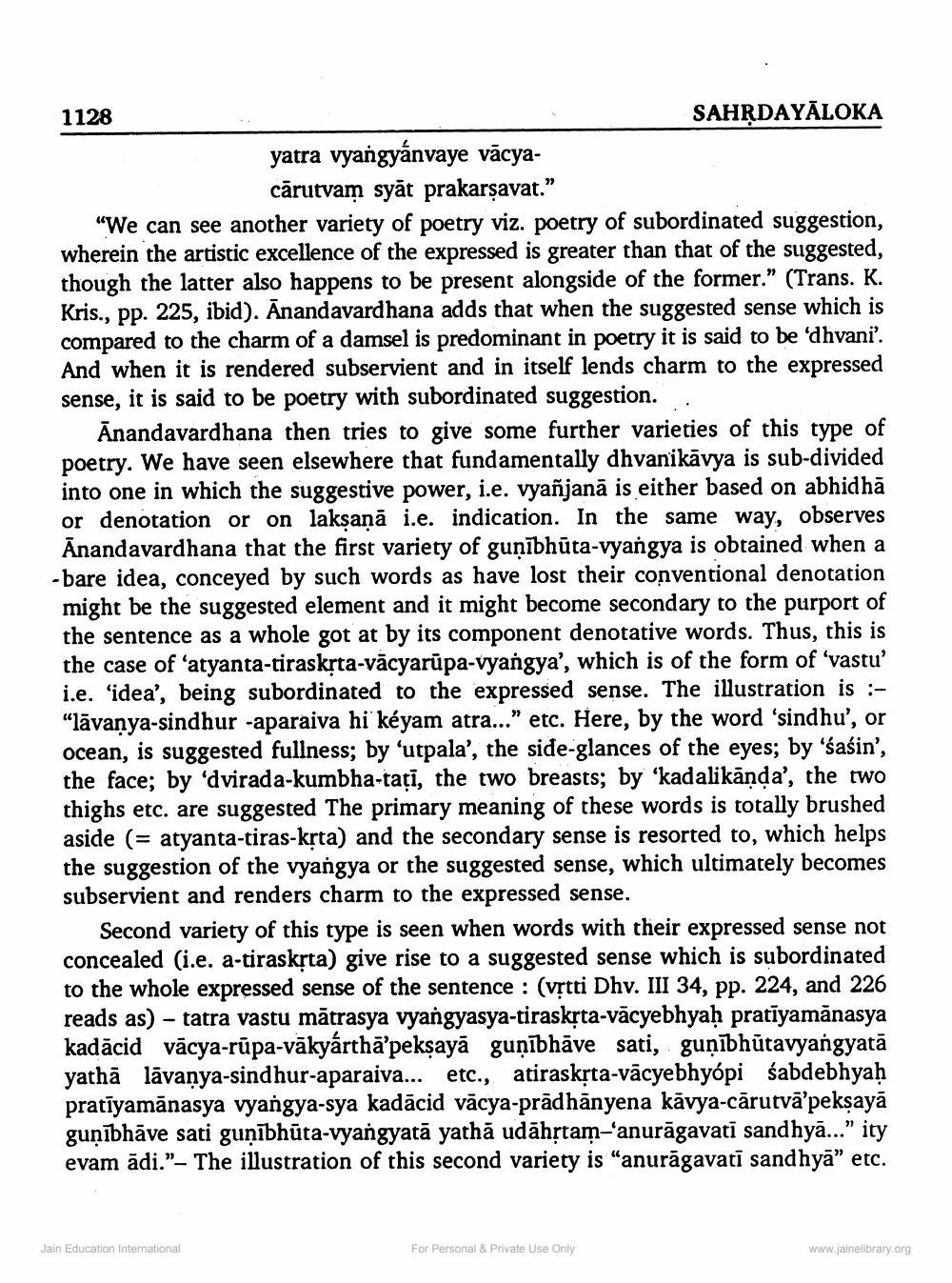________________
1128
SAHRDAYĀLOKA yatra vyangyánvaye vācya
cārutvam syāt prakarsavat.” "We can see another variety of poetry viz. poetry of subordinated suggestion, wherein the artistic excellence of the expressed is greater than that of the suggested, though the latter also happens to be present alongside of the former.” (Trans. K. Kris., pp. 225, ibid). Anandavardhana adds that when the suggested sense which is compared to the charm of a damsel is predominant in poetry it is said to be 'dhvani'. And when it is rendered subservient and in itself lends charm to the expressed sense, it is said to be poetry with subordinated suggestion..
Anandavardhana then tries to give some further varieties of this type of poetry. We have seen elsewhere that fundamentally dhvanikāvya is sub-divided into one in which the suggestive power, i.e. vyañjanā is either based on abhidhā or denotation or on laksanā i.e. indication. In the same way, observes Anandavardhana that the first variety of gunībhūta-vyangya is obtained when a - bare idea, conceyed by such words as have lost their conventional denotation might be the suggested element and it might become secondary to the purport of the sentence as a whole got at by its component denotative words. Thus, this is the case of 'atyanta-tiraskrta-vācyarūpa-vyangya', which is of the form of 'vastu' i.e. 'idea', being subordinated to the expressed sense. The illustration is :"lāvanya-sindhur -aparaiva hi kéyam atra..." etc. Here, by the word 'sindhu, or ocean, is suggested fullness; by 'utpala', the side-glances of the eyes; by 'śaśin', the face; by 'dvirada-kumbha-tați, the two breasts; by 'kadalikānda', the two thighs etc. are suggested the primary meaning of these words is totally brushed aside (= atyanta-tiras-krta) and the secondary sense is resorted to, which helps the suggestion of the vyangya or the suggested sense, which ultimately becomes subservient and renders charm to the expressed sense.
Second variety of this type is seen when words with their expressed sense not concealed (i.e. a-tiraskrta) give rise to a suggested sense which is subordinated to the whole expressed sense of the sentence : (vrtti Dhv. III 34, pp. 224, and 226 reads as) - tatra vastu mātrasya vyangyasya-tiraskrta-vācyebhyaḥ pratīyamānasya kadācid vācya-rūpa-vākyárthā'pekṣayā gunībhāve sati, gunībhūtavyangyatā yathā lāvanya-sindhur-aparaiva... etc., atiraskặta-vācyebhyópi śabdebhyaḥ pratīyamānasya vyangya-sya kadācid vācya-prādhānyena kavya-cărutvā'peksaya gunībhāve sati gunībhūta-vyangyatā yathă udāhţtam-anurāgavati sandhyā...” ity evam ādi.”- The illustration of this second variety is "anurāgavati sandhyā" etc.
Jain Education International
For Personal & Private Use Only
www.jainelibrary.org




